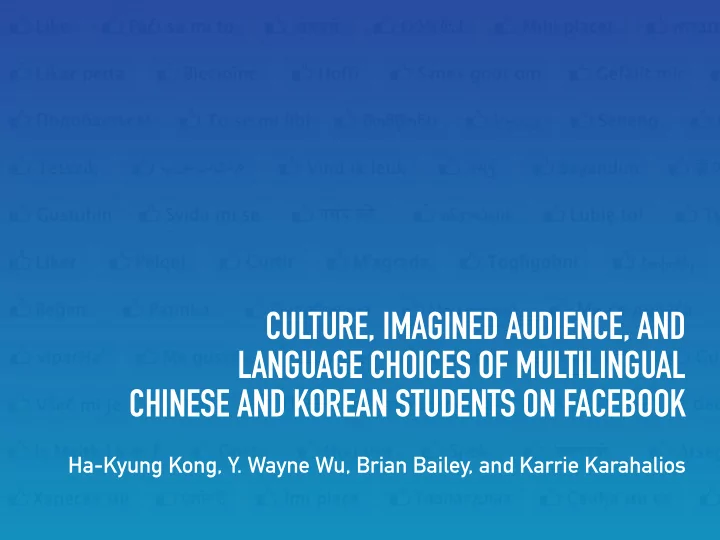

CULTURE, IMAGINED AUDIENCE, AND LANGUAGE CHOICES OF MULTILINGUAL CHINESE AND KOREAN STUDENTS ON FACEBOOK Ha-Kyung Kong, Y. Wayne Wu, Brian Bailey, and Karrie Karahalios
60% of the world population are multilin g ual speakers 1,050,000 international students in the U.S. 39% of these students are Chinese & Korean
Should I use L1 (native lan g ua g e) or En g lish?
LANGUAGE CHOICE audience context (situation and topic) social standards Fishman, J. A.. (1965). Who Speaks What Language to Whom and When?. La Linguistique, 1(2), 67–88.
LANGUAGE CHOICE ON SNS audience -> invisible and ima g ined context collapse social standards -> subjective Fishman, J. A.. (1965). Who Speaks What Language to Whom and When?. La Linguistique, 1(2), 67–88.
David : (in Korean) Jay Kim, you are becomin g g ood lookin g . What are you takin g ? Lol Jay : (in Korean) Saudi sandstorm lol Anyhow, this is someone else’s post so if we speak Korean it’s awkward [for the non-Korean poster] David : don’t care :)
RESEARCH QUESTIONS RQ1. How does the topic and the content of the post a ff ect the lan g ua g e choice of multilin g ual international students on Facebook? What role does culture play in the decision? RQ2. How does the ima g ined audience a ff ect the lan g ua g e choice of multilin g ual international students on Facebook?
PARTICIPANTS 19 participants 8 Chinese, 11 Korean 11 males, 8 females a g e ran g e: 20-40 years (mean = 25.53, s.d. = 4.31) len g th of stay in the U.S. in years (mean = 2.32, s.d. =1.29)
METHODOLOGY Part 1 Part 2 Part 3 Pre-experiment Facebook post Exploratory Semi-structured online scenario survey Visualization Interview
METHODOLOGY Part 1 Part 2 Part 3 Pre-experiment Facebook post Exploratory Semi-structured online scenario survey Visualization Interview
0. Pre-experiment
METHODOLOGY Part 2 Part 3 Part 1 Pre-experiment Exploratory Semi-structured Facebook post online scenario Visualization Interview survey
1. Facebook Post Survey
METHODOLOGY Part 1 Part 3 Part 2 Pre-experiment Facebook post Semi-structured Exploratory online scenario survey Interview Visualization
2. Exploratory Visualization
METHODOLOGY Part 1 Part 2 Part 3 Pre-experiment Facebook post Exploratory Semi-structured online scenario survey Visualization Interview
RESULTS
RQ1. Topic and Content Responses for Q4. What were your reasons for choosin g this lan g ua g e?
RQ1. Topic and Content - Culture COLLECTIVISTIC CULTURE Group welfare Hi g h-context communication Interdependence
RQ1. Topic and Content - Culture COLLECTIVISTIC CULTURE Group welfare Hi g h-context communication Interdependence
RQ1. Topic and Content - Culture - L1 “ Maybe I’m more used to complainin g in Chinese […] I think it is also related to the culture . I think in RenRen, a lot of people express their ne g ative feelin g s . In En g lish, few people complain. It’s more common to complain in Chinese. -P10
RQ1. Topic and Content - Culture - English “ I just want to introduce some Chinese culture to my American friends and international friends. In En g lish class, we have some classes about di ff erent cultures. Everyone introduced his country’s special culture to others. It’s very interestin g . -P16
RQ1. Topic and Content - Scenarios 8 SCENARIOS Hypothesis L1 1. Chinese/Korean New Year 2. Homemade food at a friend’s house En g lish 3. Group meetin g for a final project 4. Christmas g reetin g Both 5. Sellin g a car 6. Thankin g people for Birthday g reetin g s Exploratory 7. Professor sin g in g ‘Let it g o’ 8. Three day trip to New York
RQ1. Topic and Content - Scenarios 8 SCENARIOS - RESULTS
RQ2. Imagined Audience Responses for Q3. Who was your tar g et audience for this post?
RQ2. Imagined Audience - language proficiency LANGUAGE PROFICIENCY (Self-perceived) En g lish proficiency of the poster phrasin g (ex. humor) culturally sensitive L1 proficiency of the audience Respect for the audience
CONCLUSION Post Content and Cultural Considerations (RQ1) Collectivistic culture -related contents posted in L1 Sharin g cultures in En g lish Division of Ima g ined Audience (RQ2) Ima g ined audience and friendship distribution determines one’s dominant lan g ua g e Lan g ua g e proficiency of the poster and the audience
THANK YOU
Recommend
More recommend